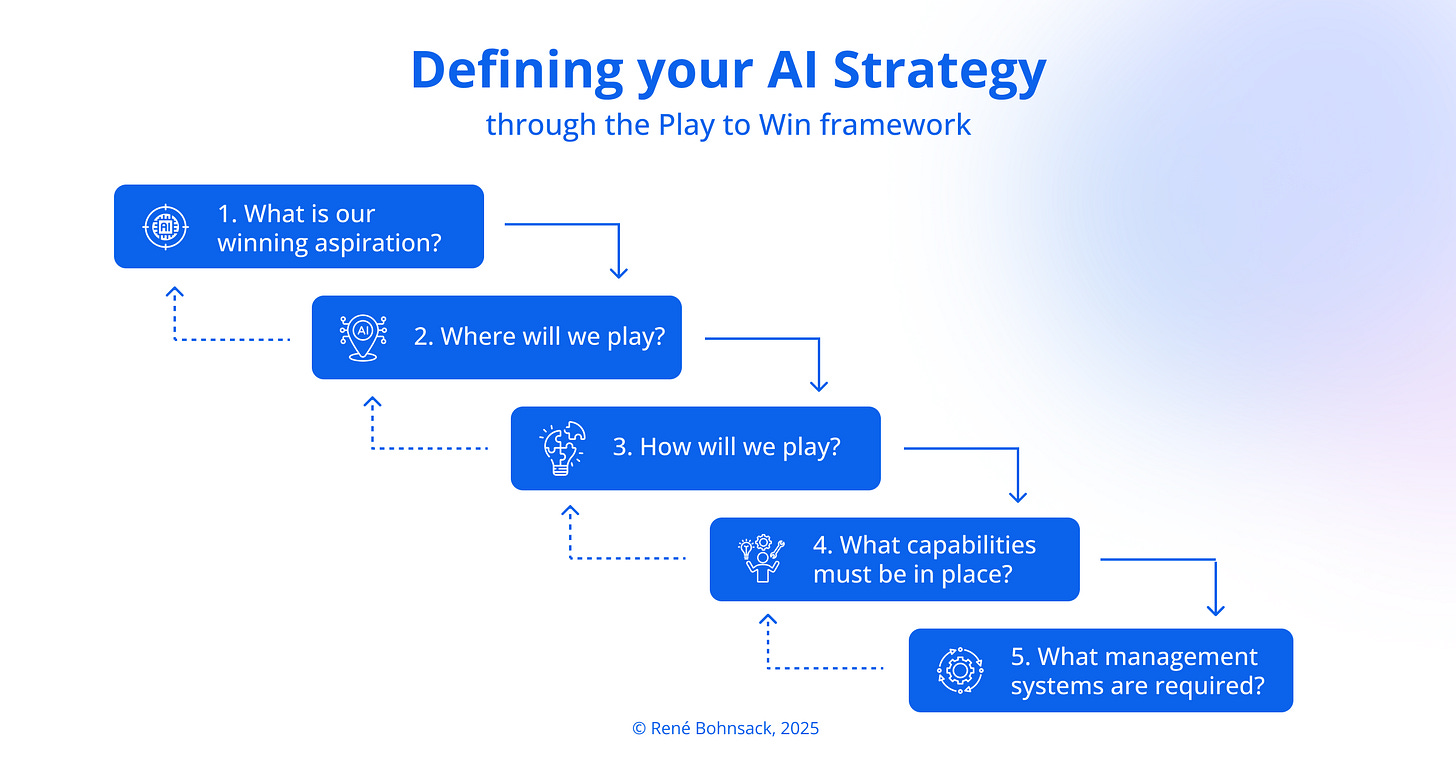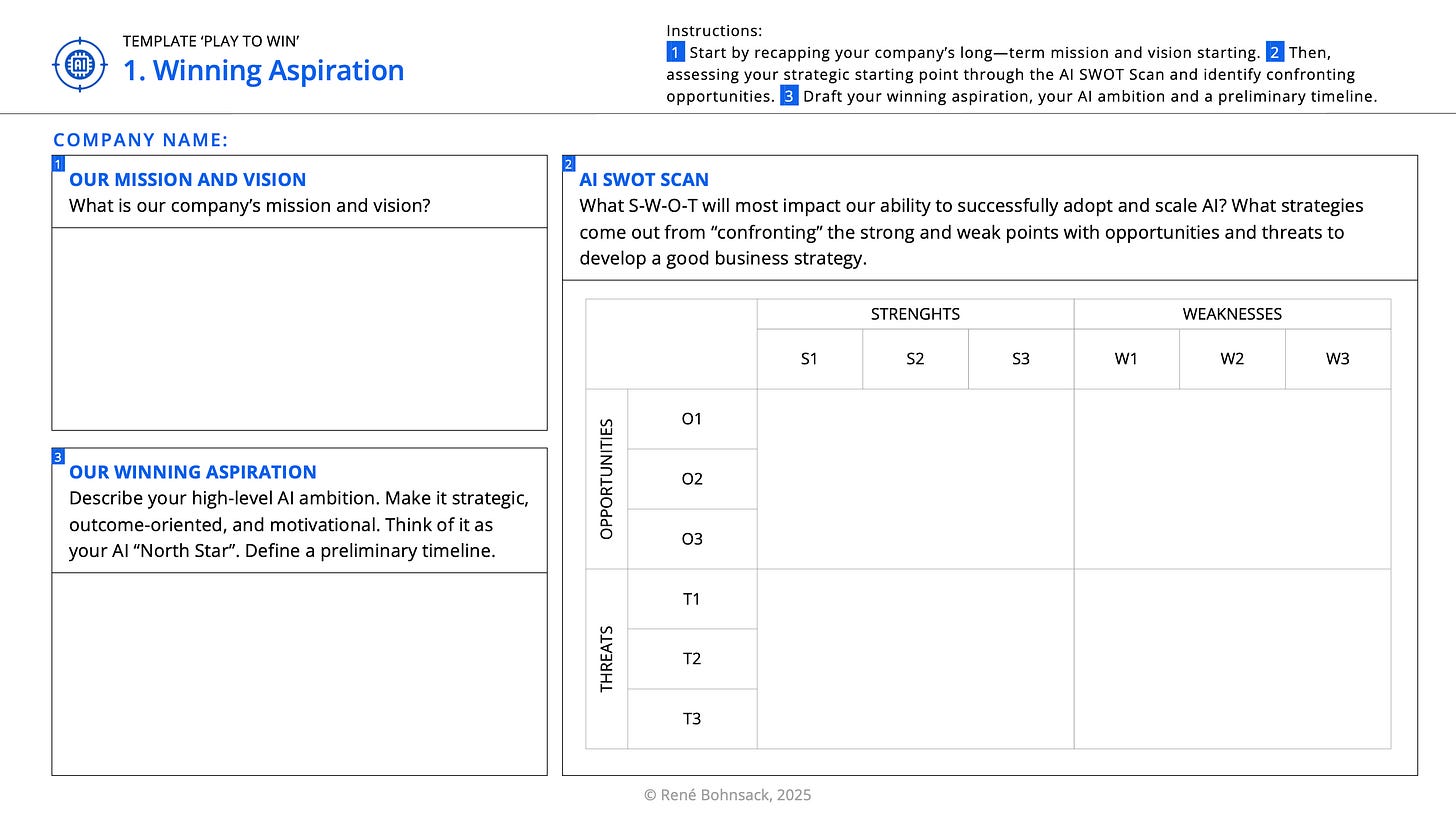You’re Doing AI Backwards: Start with Strategy, Not Tools
Play to Win framework applied to AI Strategy: Part 1 / 5
TL;DR
The Play to Win framework, created by A.G. Lafley and Roger Martin, is a powerful, proven approach to making strategic choices that drive performance.
It is especially relevant today as companies struggle to make AI a strategic asset rather than a scattered experiment. Most AI projects don’t fail due to bad tech. They fail due to unclear ambition.
In this 5-part series, we explore how to apply Play to Win to build AI strategies that actually deliver results.
Defining a Winning Aspiration sets the direction for every AI decision.
Without it, companies fall into the "AI Piloting Trap": scattered pilots, duplicated efforts, no business value.
This article helps you define your AI Winning Aspiration by tying it to your mission, doing a targeted SWOT, and writing a motivating North Star for your AI journey.
The Play to Win Framework: Origins, Success, and Relevance to AI Strategy
The Playing to Win (PTW) strategy framework was developed by A.G. Lafley, former CEO of Procter & Gamble, and his advisor Roger Martin. Formalized in their 2013 book Playing to Win: How Strategy Really Works, the framework emerged from real-world success at P&G, where it guided a dramatic turnaround. Under Lafley’s leadership, the company doubled its sales, quadrupled its profits, and added over $100 billion in market value. The core of the framework is deceptively simple: strategy is about making powerful, interconnected choices.
The heart of Playing to Win is the Strategic Choice Cascade: five key questions that together define a company’s strategy:
This framework became popular for three reasons: it was based on real business success, it simplified strategy into actionable components, and it encouraged bold, exclusionary choices. Its power lies in the clarity it provides: instead of thick planning documents, it offers a method to make decisions about focus, advantage, and capability.
Why is Play to Win relevant for AI Strategy
AI is everywhere. Yet impact is elusive. According to BCG, most companies are stuck in what they call the "AI Piloting Trap": experimentation without scale, progress without performance. While leaders scramble to deploy generative AI tools across business units, very few can explain why they're doing it. Most teams don't lack motivation or intelligence. They lack a coherent direction.
This is the tension at the heart of AI transformation today: the technology is powerful, accessible, and fast-moving. But in the absence of strategic clarity, AI becomes a scattered toolkit rather than a business capability. If you don’t know what winning looks like, how will you know if AI is helping you get there?
That is why PTW is highly relevant for AI strategy. It brings structure and purpose: AI initiatives are tied to strategic goals, directed at focused problem areas, and designed to build competitive advantage. Rather than adopting AI for the sake of innovation, leaders use PTW to ask: Where will AI help us win? How will it create unique value? What must we be great at to succeed?
Companies like Amazon, Microsoft, and others have applied this kind of thinking, explicitly or implicitly, to embed AI into their core strategy. From determining which use cases to prioritize to aligning AI investments with business outcomes, Playing to Win gives organizations a way to turn experimentation into execution.
Start With a Winning Aspiration
In the Play to Win framework, the first and most foundational step is to define your Winning Aspiration. It’s the strategic north star for every other decision you’ll make.
A Winning Aspiration defines what success looks like in clear, ambitious terms. It aligns with your broader business model and value creation logic. And it sharpens your focus by helping you say no to distractions.
Too often, I see ambition that is too vague (“We want to explore AI”), too reactive (“We want to keep up with competitors”), or too generic (“We want to be more efficient”). These statements don’t offer direction, they create noise.
Now contrast that with:
We aim to cut contract review time by 70% using GenAI by Q4.
We want to lead our industry in predictive maintenance by 2026.
We will double the productivity of client onboarding by embedding AI across the journey.
These are not slogans. They are commitments. Good aspirations are decisions. They define ambition but also create constraint. And constraint is what enables focus. Companies that articulate this well make better trade-offs, fund the right use cases, and build capabilities that matter.
What It Means for Business Leaders
If you're a business leader today, you don’t need to understand every AI tool on the market. But you do need to know where your organization is going.
Without a clear aspiration, your AI initiatives will compete for attention rather than reinforce each other. Vendors will pitch solutions that don’t align with your core challenges. And your teams will build isolated tools that look impressive but don’t move the needle.
When you lead with a Winning Aspiration, you create focus. You prioritize the functions that matter most. You align teams around a shared outcome. And you make better decisions, faster and with more confidence.
Strategy gives AI its power. Not the other way around.
Where Do You Stand? Define Your Winning Aspiration
As highlighted before, your AI Strategy must be aligned with your company’s identity and strategic goals. Before you define your Winning Aspiration for AI, step back and consider the broader context of your company. Strategy should be rooted in who you are and where you're going. AI doesn't replace your mission, it helps you fulfill it faster, better, or more boldly.
Step 1: Recap Your Mission and Long-Term Vision
Revisit your organization's purpose. What are you ultimately trying to achieve as a business? What does long-term success look like for your customers, employees, and stakeholders?
· Mission: What problem do you exist to solve?
· Vision: Where do you aim to be in 5–10 years?
This anchors your AI ambition in what matters most.
Step 2: Run an AI SWOT Scan
Use a simple SWOT to explore your strategic position:
· Strengths: What internal assets or capabilities (e.g., data, talent, digital culture) give you an edge?
· Weaknesses: Where are your limitations (e.g., legacy systems, fragmented data, skill gaps)?
· Opportunities: What external forces could AI help you capitalize on (e.g., customer expectations, market shifts)?
· Threats: What risks or disruptions might AI help you defend against (e.g., rising costs, AI-native competitors)?
Now look at the intersections:
· Where do strengths meet opportunities?
· Where do weaknesses collide with threats?
This analysis helps shape your strategy: where you can play offense and where you must build resilience.
Step 3: Write Your Winning Aspiration
Now define a clear, high-level AI ambition. Make it strategic, outcome-oriented, and motivational. Think of it as your AI North Star.
Write it down. Share it with your team. Use it as a decision filter to guide future AI investments. Here are a few guidelines:
Make it measurable and time-bound: Anchor aspirations in quantifiable outcomes (e.g., market share, customer wait time, AI coverage across services) and specific dates.
Focus on competitive advantage, not just adoption, make AI not only a tool to “keep up,” but as the core of a distinctive way to win.
Move from describing what you’ll do (build infra, hire teams) to what you’ll achieve for users, citizens, or markets.
Articulate a bold but credible North Star: One clear, motivating, future-oriented statement that becomes a rallying point for AI strategy and investment
This is not about getting the wording right. It’s about clarifying intent. You can evolve it. You can pressure-test it. But you need to write it down.
In the next part, we’ll move to the second question: Where will we play? And explore how to pick the right AI battlegrounds (read here)
Until then: where does your organization stand?
Warmly,
René Bohnsack





